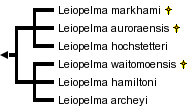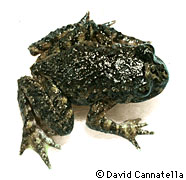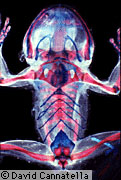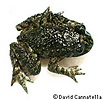Leiopelma
David Cannatella


This tree diagram shows the relationships between several groups of organisms.
The root of the current tree connects the organisms featured in this tree to their containing group and the rest of the Tree of Life. The basal branching point in the tree represents the ancestor of the other groups in the tree. This ancestor diversified over time into several descendent subgroups, which are represented as internal nodes and terminal taxa to the right.

You can click on the root to travel down the Tree of Life all the way to the root of all Life, and you can click on the names of descendent subgroups to travel up the Tree of Life all the way to individual species.
For more information on ToL tree formatting, please see Interpreting the Tree or Classification. To learn more about phylogenetic trees, please visit our Phylogenetic Biology pages.
close boxIntroduction
There are only three living species of Leiopelma (family Leiopelmatidae), and these are the only native frogs in New Zealand. Human occupation has reduced the range of these species. Leiopelma archeyi is restricted to the Coromandel Range. Leiopelma hamiltoni is known only from Stephens and Maud Islands. Leiopelma hochstetteri remains from a few isolated localities on the North Island. However, three other recently extinct species are known from cave deposits in karsted limestone regions of the North Island, and the genus was more widespread until Recent times.
Adults of the living species reach a maximum size of about 50 mm. However, the subfossil Leiopelma †waitomoensis reached approximately 100 mm in snout-vent length. Leiopelma are terrestrial and are found under stones and logs, in damp areas. They lay their eggs in similar damp areas rather than in pools of water. Rather than having aquatic tadpoles, their young undergo a more "direct" development to froglets. In Leiopelma hamiltoni and L. archeyi, the male sits over the eggs until they hatch; the froglets, still with a tail, climb up on the male's back and complete development there. In Leiopelma hochstetteri, the young move into nearby water after hatching, and there seems to be no direct parental care.
Leiopelma is unique among living frogs in having elongate pieces of cartilage in the muscles of the abdomen, called inscriptional ribs. Like Ascaphus truei, Leiopelma retains certain primitive features such as nine vertebrae in front of the sacrum, and "tailwagging" muscles. These features do not indicate a close relationship, however. Ascaphus truei and Leiopelma are distinct lineages of frogs.
As is the case with Ascaphus truei, the only taxon in the family Leiopelmatidae is the genus Leiopelma; so Leiopelmatidae is redundant. In the tree diagram we have used Leiopelma in preference to Leiopelmatidae (but there is no harm in using Leiopelmatidae).
Geographic Distribution
The distribution of the living members of the family Leiopelmatidae ais indicated in red. image info
image info
Discussion of Phylogenetic Relationships
Ford and Cannatella (1993) defined Leiopelma to be the most recent common ancestor of the living species of Leiopelma (hochstetteri, hamiltoni, and archeyi), and all of its descendants. By this definition, Leiopelma includes the three subfossil species included in Worthy's (1987) cladogram of Leiopelma.
Synapomorphies of Leiopelma include the presence of ventral inscriptional ribs, low diploid chromosome numbers (18-22), absence of horny beaks in the larvae, and reduction of opercular folds during development resulting in the lack of a closed branchial chamber and spiracle (Green and Cannatella, 1993; Stephenson, 1955).
Hay et al. (1995) analyzed relationships among families of frogs using 12S and 16S rRNA and found Ascaphus and Leiopelma to be sister-groups. This is in contrast to an earlier study of 12S rRNA sequence data by Hedges and Maxson (1993) and other recent work (Ford and Cannatella, 1993; Green and Cannatella, 1993) that found no sister-relationship between Ascaphus and Leiopelma. For more information see the account of Ascaphus truei.
References
Click here for general list of references
Title Illustrations
| Scientific Name | Leiopelma hochstetteri |
|---|---|
| Acknowledgements | frog loaned by David Green |
| Copyright | © 1995 David Cannatella |
| Scientific Name | Leiopelma hamiltoni |
|---|---|
| Specimen Condition | Dead Specimen |
| Body Part | Cleared and stained skeleton |
| Copyright | © 1995 David Cannatella |
About This Page
David Cannatella
Section of Integrative Biology and Texas Memorial Museum, University of Texas, Austin, TX 78712
Correspondence regarding this page should be directed to David Cannatella at
Page copyright © 1995 David Cannatella
Citing this page:
Cannatella, David. 1995. Leiopelma. Version 01 January 1995 (under construction). http://tolweb.org/Leiopelma/16968/1995.01.01 in The Tree of Life Web Project, http://tolweb.org/









